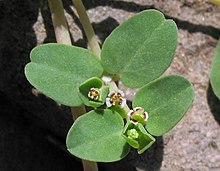
Euphorbia is a very large and diverse genus of flowering plants, commonly called spurge, in the family Euphorbiaceae. "Euphorbia" is sometimes used in ordinary English to collectively refer to all members of Euphorbiaceae, not just to members of the genus.

Chamaesyce is a subgenus of plants in the family Euphorbiaceae. Recent phylogenetic studies have shown that Chamaesyce is deeply nested within the broader Euphorbia. Specifically, Chamaesyce is very closely related to plants like Euphorbia pulcherrima, the popular poinsettia. Currently, all species have now been reclassified as species of Euphorbia. Specifically, this group now belongs to Euphorbia subgenus Chamaesyce section Anisophyllum. Taxonomically speaking, Chamaesyce is considered a synonym of Euphorbia.
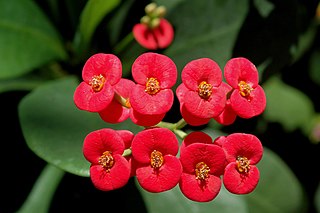
Euphorbia milii, the crown of thorns, Christ plant, or Christ's thorn, is a species of flowering plant in the spurge family Euphorbiaceae, native to Madagascar. The species name commemorates Baron Milius, once Governor of Réunion, who introduced the species to France in 1821.
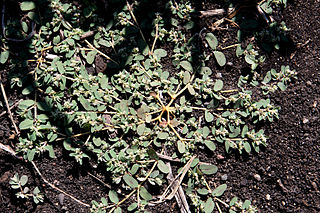
Euphorbia maculata, known as spotted spurge, prostrate spurge, milk purslane, or spotted sandmat, is a fast-growing annual plant in the family Euphorbiaceae. While it is native to North America, where it is a common garden and lawn weed in the United States, it has become a common introduced species throughout the world, including Europe, Japan, Korea, Australia, and New Zealand.

A cyathium is one of the specialised pseudanthia forming the inflorescence of plants in the genus Euphorbia (Euphorbiaceae). A cyathium consists of:

Euphorbia misera is a semi-succulent shrub in the genus Euphorbia commonly known as the cliff spurge or coast spurge. A drought-deciduous shrub, it is typically found as a gnarled, straggly plant occupying seashore bluffs, hills and deserts. Like other members of its genus, it has a milky sap, which can be found exuding out of the light gray bark when damaged. The alternately-arranged leaves are round and folded in the middle, with small hairs on them. The "flowers" can be found blooming year-round, and are colored maroon or yellow in the center with 5 white to light-yellow petal-like appendages attached outside. This species is native to the Baja California peninsula and Sonora in Mexico, and the coast of southern California in the United States, where it is a rare species. It is threatened in some localities by the development of its coastal habitat, which tends to be prime locations for high-end residential and commercial developments.

Euphorbia paralias, the Sea Spurge, is a species of flowering plant in the family Euphorbiaceae, native to Europe, northern Africa and western Asia.

Euphorbia fendleri is a species of Euphorbia known by the common name Fendler's sandmat. It is native to much of the southwestern and central United States and northern Mexico, where it grows in scrub and woodland habitat in desert and plateau regions. This is a mat- or clump-forming reddish-green plant with a crooked, creeping, hairless stem. The leaves are rounded, oval, or spade-shaped, smooth along the edges and generally coming to a point, and not much more than one centimeter in maximum length. The tiny inflorescence is a cyathium with white-edged, scalloped appendages surrounding the actual flowers. There is a ring of 25 to 35 staminate flowers around one pistillate flower. The ovary of the pistillate flower enlarges into a lobed fruit about 2 millimeters long.
Euphorbia hooveri is a species of euphorb known by the common names Hoover's sandmat and Hoover's spurge. It is endemic to California, where it grows in the rare vernal pools of the Central Valley. Due to the elimination of most of its habitat, it became a federally listed threatened species in 1997.
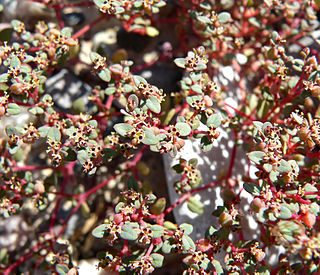
Euphorbia micromera is a species of flowering plant in the family Euphorbiaceae. It is known by the common name Sonoran sandmat. It is native to the southwestern United States from California to Texas, and northern Mexico, where it grows in sandy soils in desert and other dry habitat. It is an annual herb forming a small mat of slender stems. The hairy to hairless leaves are oblong in shape and just a few millimeters long. The tiny inflorescence is a cyathium less than a millimeter wide. It lacks the appendages that many similar species have in their cyathia. It has only a central female flower and 2 to 5 male flowers surrounded by round red nectar glands. The fruit is a minute round capsule.

Euphorbia nutans is a species of Euphorbia known by the common names eyebane and nodding spurge. It is native to much of the United States, Eastern Canada, Mexico, Central America, the Caribbean, and Venezuela.
Euphorbia ocellata is a species of Euphorbia known by the common name Contura Creek sandmat. It is native to the southwestern United States where it grows in many types of habitats. This is a small annual herb with pairs of oblong to lance-shaped leaves, each leaf up to about 1.5 centimeters long. The inflorescence is a cyathium only 2 millimeters wide. It consists of petal-like appendages surrounding the actual flowers, each with a round nectar gland at its base. The appendages are sometimes absent. The flowers include one female flower ringed by up to 60 male flowers. The fruit is a lobed, spherical capsule less than 3 millimeters wide.
Euphorbia parishii, known by the common name Parish's sandmat, is a species of euphorb. It is native to the sandy soils of the deserts in California and Nevada. It is a perennial herb forming a small patch on the ground. The slender, hairless, tangling stems have pairs of tiny, pointed oval leaves, each leaf just a few millimeters long. The minute inflorescence is a cyathium one millimeter wide. It is made up of several rounded nectar glands in shades of yellow to deep red surrounding many tiny male flowers and one female flower. The latter develops into a spherical fruit two millimeters wide.

Euphorbia prostrata is a species of spurge known by the common name prostrate spurge or prostrate sandmat.

Euphorbia revoluta is a species of euphorb known by the common name threadstem sandmat. It is native to Mexico and the southwestern United States from California to the Rocky Mountains. It is an annual herb producing thin, erect stems with pairs of linear leaves, each leaf up to 2.6 centimeters long. The inflorescence is a cyathium with rounded nectar glands surrounding one female flower and several male flowers. There are sometimes white petal-like appendages as well. The Navajo used this plant as a skin lotion.
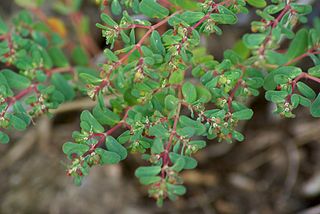
Euphorbia serpyllifolia is a species of euphorb known by the common names thymeleaf sandmat or thyme-leafed spurge. It is native to a large part of North America from Canada to Mexico, where it is a common member of the flora in many types of habitat. This is an annual herb growing as a prostrate mat or taking a somewhat erect form. The oblong leaves are up to about 1.5 centimeters long, sometimes hairy and finely toothed along the edges. The tiny inflorescence is a cyathium about a millimeter wide. It bears scalloped white petal-like appendages arranged around the actual flowers. At the center are several male flowers and one female flower, which develops into a lobed, oval fruit up to 2 millimeters wide. This plant had a number of traditional medicinal uses for many Native American groups.

Euphorbia setiloba is a species of euphorb known by the common name Yuma sandmat. It is native to the southwestern United States and northern Mexico, where it grows in dry habitat. This is a small, clumping annual herb with slender stems lined with pairs of tiny hairy leaves. Each leaf is just a few millimeters long and oval in shape with a bluntly pointed tip. The minute inflorescence is a cyathium less than two millimeters wide. It has distinctive appendages which are white with a few narrow, sharp-pointed lobes. There is a red nectar gland at the base of each. At the center of the appendages are the actual flowers, one female and several male. The ovary of the female flower develops into a hairy, spherical fruit about a millimeter wide.

Euphorbia balsamifera is a flowering plant in the spurge family Euphorbiaceae. It is distributed in the Canary Islands and the western Sahara. It is the vegetable symbol of the island of Lanzarote. Euphorbia adenensis has been treated as a subspecies of this species.

Euphorbia schizoloba is a species of euphorb known by the common name Mojave spurge. It is native to the southwestern United States, where it grows in desert hills and mountains. It is a perennial herb producing upright stems up to 40 centimeters tall, sometimes with coats of sparse hairs. The stems are lined with alternately arranged leaves which are oval with pointed tips and measure up to 2 centimeters in length. The inflorescence is a cyathium with bell-shaped bracts surrounding four tiny glands with flat, fringed appendages. At the center of this arrangement are several staminate flowers and one long pistillate flower.

Euphorbia missurica, commonly called prairie sandmat, or Missouri spurge, is a species of flowering plant in the spurge family (Euphorbiaceae). It is native to North America, where it is found primarily in area of the Great Plains. Its natural habitat is in dry, often calcareous areas, including glades, bluffs, and open woodlands.
